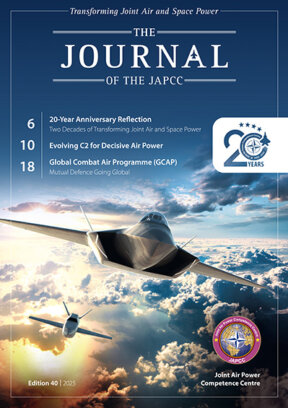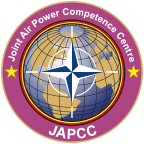Introduction
The Joint Air Power Competence Centre (JAPCC) reached a significant milestone in 2025, marking 20 years since its establishment on 1 January 2005. As NATO’s first accredited Centre of Excellence (COE), the JAPCC was formed to advocate and advance air power within the Alliance. For over two decades, the JAPCC has consistently pursued its vision to be ‘NATO’s catalyst for the improvement and transformation of Joint Air and Space Power, delivering effective solutions through independent thought and analysis’. This anniversary provides an opportune moment to recognize the JAPCC’s role in advancing NATO’s combat capability over the last two decades, while also acknowledging the changes and innovations required to meet future challenges.
In 2005, NATO found itself navigating a volatile post-Cold War security environment. The attacks of 9/11 had altered the trajectory of transatlantic defence priorities, highlighting gaps in operational readiness, doctrinal coherence, and strategic integration across domains. Operations in Afghanistan underscored the pressing need for agile, joint air capabilities that could seamlessly coordinate among allies and partners.
Recognizing this need, NATO endorsed the establishment of the JAPCC in Kalkar, Germany, with a mandate to offer independent expertise in air and space power. Designed as a multinational think tank working together with both Allied Command Operations (ACO) and Allied Command Transformation (ACT), JAPCC was tasked with bridging the gap between doctrine and execution. Its formation represented a pivotal moment – a commitment to ensuring that NATO’s air power strategy would be future-focused, collaborative, and continuously adaptive.
As a NATO accredited COE, JAPCC’s work is organized around four pillars of work:
- Concept Development and Experimentation (CD&E),
- Education, Training, Exercises, and Evaluation (ETEE),
- Doctrine Development and Standardization (DD&S),
- Analysis and Lessons Learned (A&LL).
Concept Development and Experimentation
The JAPCC’s role in CD&E is foundational to its mission of transforming joint air and space power. From its inception, the JAPCC has focused on developing and championing innovative visions, concepts, and solutions for Alliance challenges.
One consistent area of focus has been the space domain. Starting with the ‘Space Operations Assessment for NATO’ in 2008, JAPCC continuously advocated for NATO Space policy and doctrine. This persistent effort was instrumental in NATO’s official recognition of space as an operational domain in December 2019, a significant evolution in Alliance thinking. This recognition led to a dedicated Space Branch within JAPCC in 2020, and recently, contributed to the establishment of a separate NATO Space COE in Toulouse, France. The JAPCC handed over the NATO Space Department Head responsibility to the Space COE in 2023, and both COEs continue to collaborate to advance joint air and space power.
The JAPCC has also consistently explored concepts for integrating capabilities across different military domains. This evolved from early work on a ‘Network Enabled Environment’ to the contemporary development of the ‘NATO Joint All-Domain Operations (JADO)’ project, initiated in 2021. JADO, now MDO, aims to transition NATO capabilities from merely coordinated joint activities to fully integrated actions across all domains. Besides integrating domains, the JAPCC has also led air platform integration, including the 2024 development of the Air-to-Air Refuelling (AAR) Compatibility Matrix, mapping out specific NATO Allied and Partner logistical relationships.
Adapting to evolving threats is another constant in JAPCC’s CD&E. Early projects included support for Counter-Improvised Explosive Devices (C-IED) in Afghanistan, leading to numerous research studies and gap analyses. More recently, efforts have shifted to Counter-Unmanned Aerial Systems (C-UAS) studies and similar contributions addressing hybrid threats. Furthermore, the Centre has focused on enhancing base resilience, notably through the ‘Resilient Basing Enhancement Workbook’ (2022–2024), which aids nations in identifying potential vulnerabilities and mitigating shortfalls against evolving threats.
Looking to the future, JAPCC is actively developing concepts for Autonomous Collaborative Platforms (ACP) and Collaborative Combat Aircraft (CCA), recognizing their anticipated challenging role in future air superiority.
Education, Training, Exercises, and Evaluation
The ETEE pillar ensures NATO forces are prepared for advanced modern warfare against a peer adversary. Here, the JAPCC contributes by providing substantial support to NATO exercise design and execution, and by developing specialized training programmes and courses.
A hallmark of JAPCC’s ETEE contribution is its role in shaping NATO’s flagship exercises, including the ‘Steadfast’ and ‘Ramstein Ambition’ series. For two decades, JAPCC Subject Matter Experts (SMEs) have provided dynamic and realistic Opposing Forces (OPFOR) Air, Space, and Cyber, advancing NATO training against modern warfare threats.
In terms of specialized training, JAPCC led the development of Forward Air Controller-Airborne (FAC-A) simulation accreditation in 2009, allowing simulators to be used for qualification training, thereby reducing costs and improving efficiency. In addition, JAPCC has been the Office of Primary Responsibility (OPR) for NATO Force Protection (FP) courses at the NATO School Oberammergau since 2009, continuously adapting the curriculum and developing an ‘Advanced Force Protection Practitioners Course’ in 2019. In 2025 JAPCC launched NATO’s first C-UAS Fundamentals Course, teaching over 500 students in the first year alone.
Furthermore, JAPCC’s direct support to the Baltic States’ Air FP posture since 2015 has led to tangible improvements in regional security planning and resources. The Centre also maintains a valuable engagement with the European Safety & Security Professionals Network, bridging military, academic, and industrial perspectives to share best practices and influence future training curricula.
Doctrine Development and Standardization
The DD&S pillar is a less visible, but highly important, role within JAPCC. To ensure NATO’s military guidance remains current and coherent, JAPCC SMEs work behind the scenes to draft, review, and refine numerous NATO documents and policies.
A cornerstone doctrine managed by JAPCC is Allied Joint Publication (AJP) 3.3, Air & Space Operations Doctrine. Since gaining custodianship in January 2013, JAPCC has continuously updated AJP-3.3 to reflect new capabilities and operational environments, ensuring it remains foundational guidance for Alliance air operations. Similarly, JAPCC has been deeply involved in Force Protection (FP) doctrine since 2010, authoring and holding custodianship for ATP-3.3.6, NATO Force Protection Doctrine for Air Operations, and AJP-3.14, Allied Joint Doctrine for Force Protection. This ensures FP principles evolve to address new threats.
Additionally, JAPCC plays a major role in standardizing air mobility, helicopter and fighter operations, and combat logistics. It published the NATO Air-to-Air Refuelling (AAR) Flight Plan in 2011 and has consistently updated and managed AAR doctrine and procedures. JAPCC also holds custodianship of ATP-49, Use of Helicopters in Land Operations, leading its restructuring and updating. JAPCC’s support for Aircraft Cross-Servicing (ACS) efforts led to the promulgation of STANAG 3430 in 2020, enhancing interoperability. The Centre consistently contributes expertise to Alliance decision-making processes through active leadership and participation in numerous NATO committees, influencing Integrated Air and Missile Defence policy and overall NATO Security Policy.
Analysis and Lessons Learned
Under the A&LL pillar, JAPCC provides independent thought, analysis, and solutions to address challenges and inform decision makers across the Alliance. This is achieved through a diverse programme of work comprising over a hundred projects, publications, and tasks per year.
Since 2008, the JAPCC has consistently hosted its annual Air and Space Power Conference, serving as a premier forum for stimulating debate, showcasing ideas, and gathering expert feedback on critical A&S issues. Conference themes have continually evolved, reflecting contemporary challenges; for instance, 2025’s theme ‘Disrupting Dominance,’ highlights the increasing dilemmas between warfare capability (like exquisite sixth-gen fighters) and capacity (such as inexpensive drone swarms). In addition, the JAPCC Journal, published biannually, is our flagship publication, widely recognized for its thought-provoking articles from diverse experts, and serving as a vital communication channel for advocating NATO air and space power.
The JAPCC has demonstrated a strong commitment to self-assessment and strategic adaptation. An internal review in 2012 led to a comprehensive strategic transformation, re-aligning our focus towards more operationally and tactically oriented projects and enhancing engagement with NATO and Sponsoring Nations. This commitment to ‘Relevance, Rigour, and Reputation’ (principles adopted in 2010) ensures that our products remain current and impactful.
Collaborative knowledge sharing is a cornerstone of JAPCC’s A&LL. Key to this are three major forums – the Annual JAPCC Conference, the Think Tank Forum (TTF), and the Joint Air and Space Power Network (JASPN) meeting, established in 2014. These gatherings bring together national, NATO, and EU organizations to share information, identify common interests, and prevent the duplication of effort.
Beyond these recurring events, JAPCC produces in-depth analyses and reports on specific challenges. Examples include the 2008 ‘Space Operations Assessment’, the 2010 ‘UAS Concept of Employment’, the 2010 ‘Air Basing Strategy’, and the 2021 study on ‘Big Data Management in ISR and New Technology Trends’. The JAPCC’s analytical work directly informs NATO’s Defence Planning Process (NDPP) by providing essential expertise on capability requirements and development.
Conclusion
In its 20 years of existence, the Joint Air Power Competence Centre has proven to be an indispensable asset to NATO and its Sponsoring Nations. Its consistent pursuit of independent thought and rigorous analysis, coupled with its adaptive approach to emerging challenges, has allowed it to effectively guide the transformation of joint air and space power. From pioneering air policy to investigating innovative technologies like ACP, and from developing foundational doctrine to providing exercise support, the JAPCC has continuously delivered relevant and high-quality solutions.
As the security environment grows more complex, the JAPCC’s commitment to innovation, interoperability, and safeguarding Alliance interests remains paramount, ensuring that NATO’s air and space power continues to be a credible, capable, and available cornerstone of deterrence and defence. The JAPCC’s journey over the past two decades is a testament to its enduring relevance and its vital role as NATO’s catalyst for transformation.











